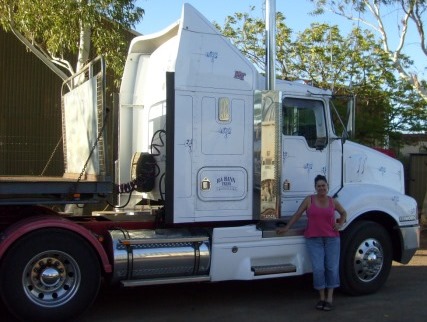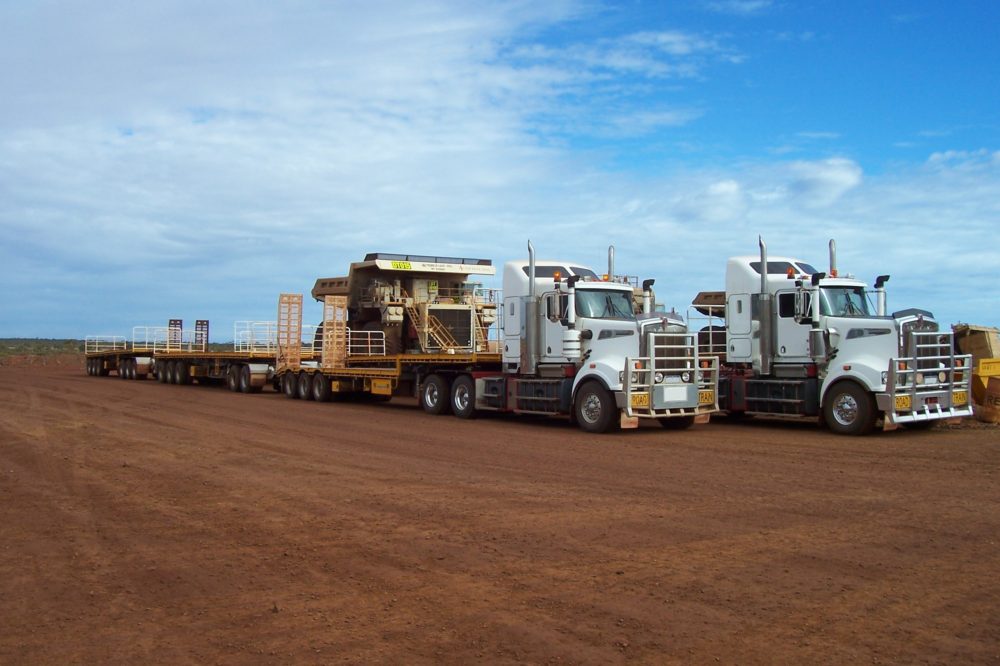By Neena Bhandari
Karratha (Western Australia), 15.11.2013: Growing up on a farm, Rosalie Hann would watch the haul trucks come in to collect wool bales and livestock. She would dream of one day driving these mammoth lorries herself. Today, the 39-year-old is an owner operator of a truck, subcontracting to Toll Energy in Dampier in the resource rich Pilbara region of Western Australia.
Rosalie is delighted to own and operate her own equipment in what is otherwise a very male-dominated industry. While women comprise about 50 per cent of the Australian population, they only make up around 10 per cent of the mine workforce. According to the Australian Bureau of Statistics’ (ABS) Labour Force Estimates for February 2010 quarter, there were 23,260 women employed in the mining industry and 4,483 of them were truck drivers.
 “Companies like to employ women truck drivers because they keep trucks cleaner, have a softer touch on the gears which help expensive tyres last longer. Also, women tend to have longer attention spans in a monotonous job of driving long hours”, says Rosalie, who lives in a 40ft transportable building in the Karratha Light Industrial Area yard, where she is able to park her truck, prime mover and trailers.
“Companies like to employ women truck drivers because they keep trucks cleaner, have a softer touch on the gears which help expensive tyres last longer. Also, women tend to have longer attention spans in a monotonous job of driving long hours”, says Rosalie, who lives in a 40ft transportable building in the Karratha Light Industrial Area yard, where she is able to park her truck, prime mover and trailers.
Women have become critical to the booming resources sector in a country plagued by skills shortages. Industry projections suggest that the minerals sector will require an additional 70,000 employees by 2015, according to a study commissioned by the Minerals Council of Australia (MCA) the Chamber of Minerals and Energy Western Australia (CMEWA) and the Department of Education, Science and Technology.
Besides driving trucks, women are employed in almost every sphere of the mining industry from geologists, mine modellers, engineers, human resource managers, plant and equipment operators to accountants.
“We often find women are more consistent in general with the operation of equipment such as our haul trucks. They tend to be more careful and gentle on machinery than some younger males. That said, we have excellent male and female operators and a combination of both in our crews is beneficial. Sometimes couples are hired, adding benefit of having two good, long-term operators working in the same team,” says CITIC Pacific Mining (CPM) General Manager (Mining) Andrew Thomson.
Sixteen out of 63 of CPM’s haul truck drivers are women and across the business, not including contractors, the company employs 189 females and 400 males.
One of the woman haul truck drivers, who works for CPM at the Cape Preston mining site and resides in Perth told this correspondent that she needed to raise quick money to pay for a deposit on a house and had heard that truck drivers were paid very well. She found the pay and perks were certainly higher than a job in the city and the only requirement was a Heavy Rigid Licence as the mining companies provide on the job training programs.
According to ABS, the weekly earning of women in the mining industry in November 2009 quarter was A$1563.60. “The money is good and I needed a new career”, says Badenia Richer, 34, who switched to truck driving after working in varied jobs for 15 years.
While some women earn quick money over a few years and leave the industry, most have been working for at least five years or more. Truck drivers can earn over A$120,000 a year in salary in addition to perks such as a `rest and recuperation’ flight to the state capital Perth every month. The industry mostly has fly in/fly out workers, who spend on an average two weeks on the mining site and one week at home in Perth.
For these women, being away from family and friends for two weeks at a stretch can be difficult and get lonely. They miss loved ones and festivities like birthdays and weddings. Sometimes 12-hour shifts can be a challenge, especially working night shifts if they haven’t been able to sleep a wink during the day. Despite the challenges, they enjoy the constant changing environment the job offers.
The average age of women truck drivers is between 30 and 45 years. Rachael Williss, 27, sub contracts to Toll Energy on the Burrup Peninsula in Karratha, located 1,535 kilometers north of Perth, and lives on a house boat in the Hampton harbour in nearby Dampier.
“I love driving whether it’s my four wheel drive, go-kart or motorbike and enjoy being on the open road with rolling country side. Driving gives me the opportunity to catch up with a lot of friends, meet new people and it also gives me the freedom to choose my own work hours”, says Rachael, who has extensively travelled and worked in a variety of fields from child care to farming.
She is disappointed when people comment, “Oh, you are just a truck driver”. Rachael says, “There is much more to trucking than just driving. Women that are in this industry are generally in it because they want to, as opposed to many males who have just fallen into the job. Most women make it their business/career and succeed because they are multi-skilled”.
But juggling home and hearth is a challenge. “My partner also drives a truck so that makes it a lot easier for us to understand each other. However, living on a house boat requires a lot of maintenance time. Also, working for yourself doesn’t always bring too many perks and trucks and equipment cost an arm and a leg when something goes wrong, but it’s definitely all worth it”, says Rachael.
Agrees Rosalie, money is good, but bills are hefty too e.g. two front tyres cost A$1400. She has just bought a new truck and intends to stay within the industry for at least another five years, but feels if she had children, it would be difficult working six days a week, starting at 7am, depending on the workload it can be a 4hr to 12hr day.
So what difficulties do women encounter in such a demanding and physically exacting job? Rachael laughs, “Probably my size, because it means that I need to put a lot more effort and strength into everything I do, which say a man would find a lot easier. I still have no problem lifting and changing a tyre”.
Australia’s mining sector employs more than half a million people and brings in $115 billion in export earnings. But as Julie Marchesi, who works as a Container Manager in Dampier says, “It is a man’s world. One needs to learn the skills essential to combat the lack of respect, which is very high. Men use this “team” or “boys club” thing which keeps you locked out. To combat this I try to be one of them, this means being tougher, swearing, doing “boy things” and in some circumstance using my feminist ways too, letting them think that they are smarter”.
It can also be tough being in the heat of up to 50 degree centigrade for a number of days sometimes, when everything you touch is red hot, dry and dusty. “Your skin and hair suffer. Drinking water is not good so you have to purchase water and this becomes an unavoidable expense. Rents are up to A$2200 a week so shared accommodation is inevitable and a room can cost between $350 – $500 per week, excluding amenities, this means no real privacy. On the other hand, it is a very friendly town as with few social places and events we meet the same people all the time” says Julie.
For all the challenges, trucking is just another male bastion, where women are making a mark.
© Copyright Neena Bhandari. All rights reserved. Republication, copying or using information from neenabhandari.com content is expressly prohibited without the permission of the writer and the media outlet syndicating or publishing the article.



